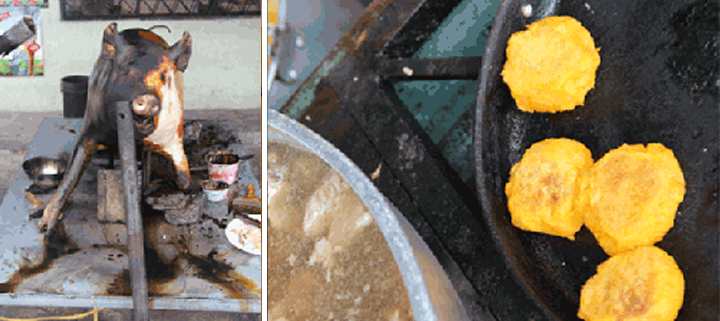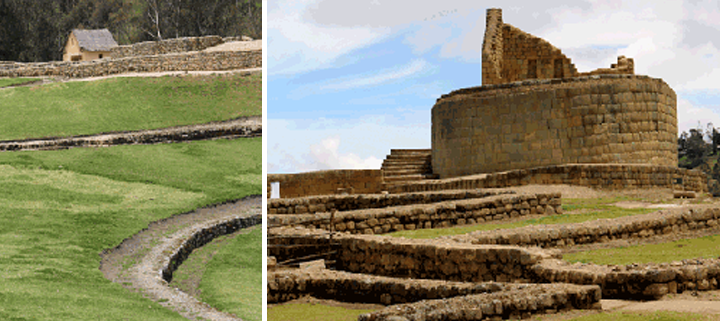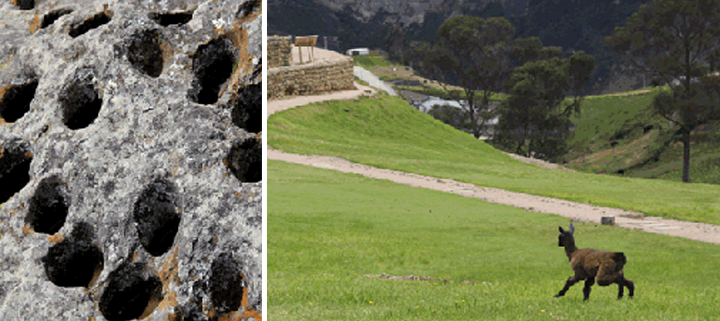Adventure in
Ecuador
As
my plane nearly turned sideways to enter the narrow valley where Quito
is located, for the first time in all of my travels, the oxygen masks
fell down. I was naturally scared to death, but I knew what to
do. Put on the mask and breathe deeply. Some announcement
was made in Spanish which I couldn't comprehend. Nobody
bothered to make any announcement in English. Finally, a
stewardess communicated to me that it was all a false alarm. No
need to breathe through a mask or panic. Too late! The
damage had already been done to my nerves and my heart.
Safely on land, arrangements were made for my tour of Ingapirca, Ecuador's best known Inca ruins. I was to meet my guide in front of the old cathedral. I recognized Javier as soon as I saw him. I met him the day before, outside my hotel. He thought I was the person he was to guide for the trip around Cuenca. He remembered me, too. One of the first things he said was, "You're going to see llamas today."
Safely on land, arrangements were made for my tour of Ingapirca, Ecuador's best known Inca ruins. I was to meet my guide in front of the old cathedral. I recognized Javier as soon as I saw him. I met him the day before, outside my hotel. He thought I was the person he was to guide for the trip around Cuenca. He remembered me, too. One of the first things he said was, "You're going to see llamas today."

Roasted Pig and Llapingachos
There
was an unplanned stop along the road on our trip towards Cañar.
It was both delicious and unexpected. At a roadside diner we saw
a whole pig in the process of being flame roasted, and not in the
usual manner. The cook used kind of a blow torch use to char the
skin black. Then portions of that burnt skin were sliced off as
customers placed orders. The skin was tossed but the layer of
crispy fat underneath was a treat. Well, it wasn't for me.
I gave it to two Ecuadorian ladies who were just so thrilled to have
extra - about as thrilled as I was to get rid of it. The rest of
my little dish had roasted corn kernels, bits of pork, and my
treasured llapingachos (potato patties).
It wasn't far to Ingapirca, the Inca Wall. The area was built upon a site of the Cañari people who inhabited the area before the Incas. They worshiped the moon and traditionally had a queen. The Incas worshipped the sun, and their king united the people by marrying one of those powerful women.
Near the entrance of the grounds was the Temple of the Moon. Cañari architecture was traditionally round. And, in the Temple of the Moon there was a round gravesite. Apparently, when the queen died, all of her helpers were killed along with her so her afterlife would be easier. My guess is the royal court wished her a long and happy life.

At the other end of the grounds, on the highest point, was the Temple of the Sun. Inca architecture was built with amazing precision. Rocks were cut to shape and placed so tightly that not even a piece of paper could slip between them. There was no need for mortar. This temple was no exception. However, unlike most Inca architecture that was geometric and square, the Temple of the Sun in Ingapirca is oval. This makes archeologists believe it was constructed on top of a previous Cañari temple.
Neither of the temples was my favorite thing at the ruins. There were a few rocks that had unusual holes carved into them. Javier asked what they could be. I suggested they were to hold Coke bottles, the sacred drink of the Incas. It was a good guess, but in spite of a lot of advertisement, that wasn't "the real thing".

The real thing was a calendar. The Cañari observed the stars and tracked their course over the year. Those holes had water in them. A star might reflect in one hole in January and reflect in another hole a few months later. Each calendar had 13 holes. A lunar cycle is 28 days. Here's a simple math lesson for you, 13 x 28 = 364 days. My guess is the Cañari were pretty good at what they did.
We saw more rocks with holes carved into them. There were rocks that held poles in them to support buildings as well as holes carved for locks in the walls. Other rocks looked like rectangular benches with a hole at each end. I thought it was for a place to put your Coke bottle when you rested from moving all those other rocks. Again, I was wrong.
The tour couldn't have ended on a better note. At the beginning of the walk, there were llamas across a field (that we were not allowed to cross. Stay on the path, tourists.) But, as I was about to leave Ingapirca, the llamas decided to cross the path and my path. I got the photos I really wanted to take. And, Javier was right about the llamas.
It wasn't far to Ingapirca, the Inca Wall. The area was built upon a site of the Cañari people who inhabited the area before the Incas. They worshiped the moon and traditionally had a queen. The Incas worshipped the sun, and their king united the people by marrying one of those powerful women.
Near the entrance of the grounds was the Temple of the Moon. Cañari architecture was traditionally round. And, in the Temple of the Moon there was a round gravesite. Apparently, when the queen died, all of her helpers were killed along with her so her afterlife would be easier. My guess is the royal court wished her a long and happy life.

The
Temple of the Sun
At the other end of the grounds, on the highest point, was the Temple of the Sun. Inca architecture was built with amazing precision. Rocks were cut to shape and placed so tightly that not even a piece of paper could slip between them. There was no need for mortar. This temple was no exception. However, unlike most Inca architecture that was geometric and square, the Temple of the Sun in Ingapirca is oval. This makes archeologists believe it was constructed on top of a previous Cañari temple.
Neither of the temples was my favorite thing at the ruins. There were a few rocks that had unusual holes carved into them. Javier asked what they could be. I suggested they were to hold Coke bottles, the sacred drink of the Incas. It was a good guess, but in spite of a lot of advertisement, that wasn't "the real thing".

The
"Real" Calendar
The real thing was a calendar. The Cañari observed the stars and tracked their course over the year. Those holes had water in them. A star might reflect in one hole in January and reflect in another hole a few months later. Each calendar had 13 holes. A lunar cycle is 28 days. Here's a simple math lesson for you, 13 x 28 = 364 days. My guess is the Cañari were pretty good at what they did.
We saw more rocks with holes carved into them. There were rocks that held poles in them to support buildings as well as holes carved for locks in the walls. Other rocks looked like rectangular benches with a hole at each end. I thought it was for a place to put your Coke bottle when you rested from moving all those other rocks. Again, I was wrong.
The tour couldn't have ended on a better note. At the beginning of the walk, there were llamas across a field (that we were not allowed to cross. Stay on the path, tourists.) But, as I was about to leave Ingapirca, the llamas decided to cross the path and my path. I got the photos I really wanted to take. And, Javier was right about the llamas.
